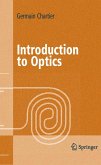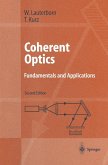This new edition is intended for a one semester course in optics for juniors and seniors in science and engineering; it uses scripts from Maple, MathCad, Mathematica, and MATLAB provide a simulated laboratory where students can learn by exploration and discovery instead of passive absorption. The text covers all the standard topics of a traditional optics course, including: geometrical optics and aberration, interference and diffraction, coherence, Maxwell's equations, wave guides and propagating modes, blackbody radiation, atomic emission and lasers, optical properties of materials, Fourier transforms and FT spectroscopy, image formation, and holography. It contains step by step derivations of all basic formulas in geometrical, wave and Fourier optics. The basic text is supplemented by over 170 files in Maple, MathCad, Mathematica, and MATLAB (many of which are in the text, each suggesting programs to solve a particular problem, and each linked to a topic in or application of optics. The computer files are dynamic, allowing the reader to see instantly the effects of changing parameters in the equations. Students are thus encouraged to ask "What if?" questions to asses the physical implications of the formulas. The discussion of Fourier transforms in particular is enhanced by the availability of numerical methods. The book is written for the study of particular projects but can easily be adapted to other situations. The threefold arrangement of text, applications, and files makes the book suitable for "self-learning" by scientists or engineers who would like to refresh their knowledge of optics.In the classroom, the Maple, MathCad, Mathematica, and MATLAB scripts can serve as starting points for homework; outside, they can help find solutions to complex problems in engineering applications. Some praise for the previous edition: OPTICS AND PHOTONICS NEWS [OCTOBER 2004] "This book cover geometrical optics, electromagnetic theory, interference, diffraction and coherence theory. Chapters on optical constants, blackbody radiation, emission and absorption, lasers, holography and Fourier transform spectroscopy broaden its scope. The packet contains over 170 MathCAD files linked to specific topics and applications. ... [T]he main virtues of the book are the excellent photographs of basic optical phenomena. ... The index is comprehensive. ... [The book] will certainly be helpful to ... students in an introductory optics course." THE PHYSICIST (March/April 2004) "The author has developed a suite of model programs covering the whole spectrum of optics from classical geometric ray to wave and modern optics. Illustrative resonator and waveguide modes are also part of the program mix as well as introductory laser theory. In addition to an optics course, this book would be useful in a 3rd or 4th year electromagnetism course as well as an introduction to lasers and resonators. There are certainly more topics in this text than could possibly be covered in the typical 30 hour one semester course. ... All formulas and diagrams are provided in Adobe .pdf files as well for transcription into other software suites or inclusion in notes. This book is a comprehensive optics text that has been written in a mode to encourage students to run the models, do the calculations and generate their own illustrations. ... The book would serve as an excellent text for undergraduate use and reference for laboratory simulation experiments."
Dieser Download kann aus rechtlichen Gründen nur mit Rechnungsadresse in A, B, BG, CY, CZ, D, DK, EW, E, FIN, F, GR, HR, H, IRL, I, LT, L, LR, M, NL, PL, P, R, S, SLO, SK ausgeliefert werden.
Some praise for the previous edition:
OPTICS AND PHOTONICS NEWS [OCTOBER 2004]
"This book cover geometrical optics, electromagnetic theory, interference, diffraction and coherence theory. Chapters on optical constants, blackbody radiation, emission and absorption, lasers, holography and Fourier transform spectroscopy broaden its scope. The packet contains over 170 MathCAD files linked to specific topics and applications. ... [T]he main virtues of the book are the excellent photographs of basic optical phenomena. ... The index is comprehensive. ... [The book] will certainly be helpful to ... students in an introductory optics course."
THE PHYSICIST (March/April 2004)
"The author has developed a suite of model programs covering the whole spectrum of optics from classical geometric ray to wave and modern optics. Illustrative resonator and waveguide modes are also part of the program mix as well as introductory laser theory. In addition to an optics course, this book would be useful in a 3rd or 4th year electromagnetism course as well as an introduction to lasers and resonators. There are certainly more topics in this text than could possibly be covered in the typical 30 hour one semester course. ... All formulas and diagrams are provided in Adobe .pdf files as well for transcription into other software suites or inclusion in notes. This book is a comprehensive optics text that has been written in a mode to encourage students to run the models, do the calculations and generate their own illustrations. ... The book would serve as an excellent text for undergraduate use and reference for laboratory simulation experiments."
From the reviews of the second edition:
"Möller (physics, NJIT) presents introductory-level coverage of the basics in optics and provides model computational files for simulation of the governing laws. ... Selected classical textbook references are listed at the end of the book. Summing Up:Recommended. Upper-division undergraduates." (O. Eknoyan, CHOICE, Vol. 45 (6), 2008)
"In this book Möller presents an impressive procedure of studying optics using the computer through the packages of Algebraic Computation. ... It is very well written. ... I believe that a dedicated professor could use this book to design physics projects with his interested students. It would be a pleasure for both." (Everton Murilo C. Abreu, Mathematical Reviews, Issue 2009 c)
"The book is aimed at readers who want to learn the basics of optics by using model computations. Step by step all basic formulas in geometrical, wave and Fourier optics are derived and supplemented by programs to solve a particular problem linked to a topic in optics or some application. ... The book is intended for a one semester introductory optics course, but also suitable for self-learning by scientists or engineers who would like to refresh their knowledge of optics." (Gunther Schmidt, Zentralblatt MATH, Vol. 1179, 2010)
OPTICS AND PHOTONICS NEWS [OCTOBER 2004]
"This book cover geometrical optics, electromagnetic theory, interference, diffraction and coherence theory. Chapters on optical constants, blackbody radiation, emission and absorption, lasers, holography and Fourier transform spectroscopy broaden its scope. The packet contains over 170 MathCAD files linked to specific topics and applications. ... [T]he main virtues of the book are the excellent photographs of basic optical phenomena. ... The index is comprehensive. ... [The book] will certainly be helpful to ... students in an introductory optics course."
THE PHYSICIST (March/April 2004)
"The author has developed a suite of model programs covering the whole spectrum of optics from classical geometric ray to wave and modern optics. Illustrative resonator and waveguide modes are also part of the program mix as well as introductory laser theory. In addition to an optics course, this book would be useful in a 3rd or 4th year electromagnetism course as well as an introduction to lasers and resonators. There are certainly more topics in this text than could possibly be covered in the typical 30 hour one semester course. ... All formulas and diagrams are provided in Adobe .pdf files as well for transcription into other software suites or inclusion in notes. This book is a comprehensive optics text that has been written in a mode to encourage students to run the models, do the calculations and generate their own illustrations. ... The book would serve as an excellent text for undergraduate use and reference for laboratory simulation experiments."
From the reviews of the second edition:
"Möller (physics, NJIT) presents introductory-level coverage of the basics in optics and provides model computational files for simulation of the governing laws. ... Selected classical textbook references are listed at the end of the book. Summing Up:Recommended. Upper-division undergraduates." (O. Eknoyan, CHOICE, Vol. 45 (6), 2008)
"In this book Möller presents an impressive procedure of studying optics using the computer through the packages of Algebraic Computation. ... It is very well written. ... I believe that a dedicated professor could use this book to design physics projects with his interested students. It would be a pleasure for both." (Everton Murilo C. Abreu, Mathematical Reviews, Issue 2009 c)
"The book is aimed at readers who want to learn the basics of optics by using model computations. Step by step all basic formulas in geometrical, wave and Fourier optics are derived and supplemented by programs to solve a particular problem linked to a topic in optics or some application. ... The book is intended for a one semester introductory optics course, but also suitable for self-learning by scientists or engineers who would like to refresh their knowledge of optics." (Gunther Schmidt, Zentralblatt MATH, Vol. 1179, 2010)









